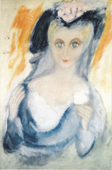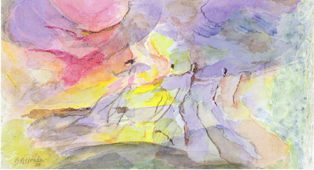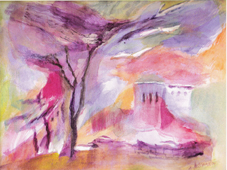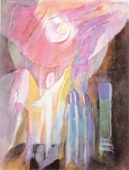| |
| |
|
|
| |
In the experience of Luciano Balduino
PAINTING THAT SPRINGS FROM THE SOUL
 |
| Bianca - B. Assenza * (Private collection) |
The highly original “colour method” thought up by Assenza and practised by many of his pupils working in countries worldwide has by now gained such fame as to be considered by many people as an extremely valid pathway to the realization of R. Steiner’s motto “painting extracting from colour”.
Rosario Giuseppe Assenza (1905-1985) was born in Modica, Sicily. From his earliest childhood he showed great artistic talent, so that on the completion of his studies in this field he became a great painter.
While he was still young, he produced noteworthy works in churches and public buildings in his native land. He then moved to Milan, to France and to Germany in search of new impulses in the development of his art.
Settling later in Rome, he worked as a highly considered portrait painter. Finally he moved to Dornach in Switzerland in 1957, where he continued for many years to dedicate himself to the research, begun in Italy, into the way to get to the bottom of Rudolf Steiner’s motto “painting extracting from colour”, but which, when applied conscientiously, allow to produce valuable paintings both from the point of view of the content and from that of style and technique.
A full biography of the Master can be found in the following works:
-
Emanuele Minardo “Beppe Asssenza, life and works of the Author of the Method of Colour in Anthrosophia” Edizioni EdiArgo 2005.
-
Klaus Hartmann Greet Helsen Durrer “Beppe Assenza, ein leben für die Malerai und Anthrosophie“ Gideon Spicker Verlag 2005
The proposal of Rudolf Steiner for a different way of painting in which the painter, instead of shaping the material by sinking his own sentiments or interior visions in it, grasps the life, the essence of the colour and extracts the IDEA from it, for a painting that reflects the action of the living colour, is no easy achievement.
First of all one should not be attracted by the colour as it appears in the world outside us, in objects, but grasp it as living and freely fluctuating in the soul. Only when it is taken into the artist’s consciousness, in its own nature and essence, does the soul acquire the capacity to elaborate it in line with the intrinsic qualities and properties of the colour itself, coming to see lines and forms emerge from its natural development.
The artist searches to grasp, by interpreting the latter, the content of those chromatic compositions that have been developing, or rather, just a minimal part of the universe of colour that lives and fluctuates within it. The IDEA of the painting is born from this intimate experience.
A pictorial procedure that is able to perform such a demanding task cannot be left to improvisation. It needs above all a particularly acute sensibility of the artist and not just this. The artist must in turn develop a way of proceeding that, while operating in full conformity with the natural requirements of the colours, allows the reaching of the creation of forms and the consolidation of the IDEA, without merely subjective interference.
Assenza worked for many years on the interior experimentation of colour and on the research for a procedure allowing to transfer the lived experience into the material, up to the realization of a chromatic composition that is live and touching and which is the source of significant forms and figures.
His personal experience led to a vast series of studies, which came to constitute his “method of colour”, further rounded off with increasingly interesting exercises.
It is certainly complex and profound, as it springs from interior experience, which is felt strongly and so is true, human and realistic. Assenza, with his spirit of dedication, has made it available to his students. This writer can merely try to offer some brief notes on it as to how he took it on and lived it so that the students could draw useful arguments for their own research. |
 |
 |
|
 |
| |
|
|
| |
AN EXPERIENCE OF COLOUR
Just as with other methods based on Goethe’s theory, we start with the experimentation of single colours and their dynamic properties of contraction, expansion and relaxation indicated by Rudolf Steiner (see the chapter above).
Right from the start of these first works, and even more so from the following ones, Assenza’s method takes on the character of particular developments. They are so designed as to offer the student the opportunity to develop that sensibility required to perceive in the soul the essence of the colour and its free fluctuating.
 |
| Dryades - B. Assenza ** |
PRINCIPLES OF GOETHE’S PAINTING
This experience is reached only if and when colours are contemplated in complete “interior silence”. Then they “speak” to the soul of the painter. This is the basic and essential behaviour required to achieve Steiner’s intentions and it is the first thing that the student must learn.
Assenza suggested that the different colours with their respective different tonalities were experimented in increasingly changeable situations, with the consequent inherent varied possibilities of contracting, expanding and placing themselves, following their dynamic properties. They form the basic element for the following creation of forms.
The transition to the resonance of two colours opens the way to a world of always novel sensations.
Here, the Master felt, it is essential to grasp intimately the sentiments set free by the different intervals, that is of the relations that cross between the colours according to where they stand in relation to one another through tangents and chords, or are diametrically opposed in Goethe’s circle. The sensations derived are defined by Goethe as respectively “characterless” “characteristic” or “harmonic”.
Assenza insisted particularly that his students should learn to experiment internally with the value of intervals that is the differentiation of their qualities that are potential sources of sensations. The general sensation of the whole chromatic set up depends on them.
The experimentation becomes ever increasingly wealthy as the combinations of colours were made to come to life in multiple and different conditions of distribution in space. Ever new sensations were felt also because of what from time to time came into being with the overlapping of colours, with their rejection or attraction based, on their respective dynamic properties.
Here we should pay attention to the reciprocal relations of “weight and measure” (as Steiner defines them) that is to the intrinsic weighting qualities for each colour and the respective expansion in space. The correct observation too of these relations, which Assenza considered to be a primary task, becomes the motive for further elaborations and mutations.
Now the composition is ready to accept the inclusion of a third colour independently of those arising spontaneously from the previous overlapping and veiling. It is decisive in offering consistency and completion in the painting. With this, one realizes what Steiner defined as the “chord”, or the “totality”, according to Goethe.
The third colour is usually complimentary to the existing principal one in the combination and has the aim of creating a “harmonious” relationship.
The elaboration, in the form of an “experience of colour”, so enters into the central and most important phase of its development. Assenza makes use of what he calls characterizations to realize it in the best way possible.
The student, who has learned to perceive in the interiority the essence of colour, must now seek to grasp what the chromatic composition or the single colours that composed it would like to express, what is their content and what further development they would require.
What the artist perceives as the element which expresses the meaning of a combination or of a particular surface of colour will be made to emerge with decisive interventions, that is, with the insertion of new colours or the strengthening of some existing ones which are consciously applied with measured strokes in determined points.
Thereby certain parts of the painting will take on a more significant role and will form the bearing structure, while other colours will simply appear as “spaces”, that is, will represent the environment within which the characterization, that has been made, will suggest the continuation of the elaboration.
We find again an essential and highly original aspect of Assenza’s method in the procedure of “characterization”.
In this respect, the writer wishes to recall the great insistence of the Master in recommending that students should go beyond the observation of intervals and dynamisms, in particular also to the need of characterization.
 |
| Image 004 - B. Assenza * |
All these points are utterly essential for the execution of a good chromatic composition, according to Goethe’s theory and the understanding of Rudolf Steiner.
Continuous metamorphoses will be derived from all the different interventions, all the more so as for every insertion of colours or strokes in a part of the painting there has to be a corresponding reworking of the others to reestablish the equilibriums.
Contrasts and tensions will also and inevitably result form this. For Assenza they take on a major value insomuch as they give life and character to the painting even if, naturally, they will need to be counterbalanced by areas of relaxation. In the same way, great importance must be attributed to chiaroscuro and to perspective too which is derived exclusively from the quality of the colours.
What we have described up to now represents the first stage of the Assenza method, that is the mere experience of colour lived intimately.
|
 |
 |
|
 |
| |
|
|
| |
CREATION OF THE FORM
During the elaboration, the boundaries between the different colour surfaces will have become more or less apparent. The more evident ones will describe the “movements” that in the careful observer’s eye will take on the aspect of lines running through the whole chromatic composition. We call them gestures. Certain surfaces or masses of colour created by dynamisms will appear more limited and condensed. The surroundings, or rather the gestures that highlight them, will make them appear as forms in their own right.
 |
Watercolour (Untitled) B.Assenza*
(private collection) |
We should remember that gestures and forms are just the natural result of a chromatic process and not the realization of a thought or a project.
The gestures and forms are the first basic elements in undertaking the development of the composition that is a bearing and harmonic structure corresponding to the real content of the chromatic structure. Assenza considers this phase of work of primary importance.
The Master taught how to observe the gestures, to follow and seek in them the principle lines that hold up the chromatic texture, and he invited students to seek and recognize the emerging forms that had developed spontaneously. Then to highlight the former and the latter and, if required, to modify, correct and move them in order to obtain a meaning and a balance, in the network of gestures, the aspect and collocation of the forms. Assenza was used to require the achievement the creation of an overall harmony.
This is an operation that requires great diligence and delicacy. It is important to avoid equivocation of blocking out pedantically all the surfaces and masses of colour following the progress made. One should instead “listen to” what flows from the chromatic texture and its meaning itself with the soul and “feel” what appears to be the following of the most suitable line for expressing the content.
 |
|
He is arisen - B. Assenza ** |
Assenza liked to define this line the “melodic line” and this was true because the event was to be felt in the soul just like music.
Also he suggested tracing it graphically in order that the student became completely conscious of it.
Other lines spread out from the melodic line that are secondary to the primary one and act as its extensions. Alternatively independent lines could emerge, but always correlated with the first. This all came to constitute a structure or network, which highlights the more important and basic elements of the chromatic texture.
Among them all were emerging those masses of colour that merit assuming an overall role, that the student should see to stressing in order to give them the aspect of significant forms in their own right
Now the student can concentrate his full attention on them. Perhaps they need to be improved or better orientated in space to be inserted harmoniously in the whole.
Much attention must be paid to avoid them appearing, in their mode of existence, extraneous to the context, but instead as an integral part.
It should be stressed that Assenza suggested performing such a complex work graphically only for teaching purposes. The skilled painter can stop at just a few strokes or even more simply can live in his soul the entire procedure described here and so outline the forms an immediate fashion.
At its conclusion, the elaboration comes to create a significant and harmonious architectonic structure, a basis for a by now nearby springing up of an IDEA.
This is the second stage of Assenza’s method. Therefore the main interest in it lies with the compositional element. |
 |
| |
 |
|
 |
| |
|
|
| |
BIRTH AND INCORPORATION OF THE IDEA
Now, through the artist’s sensibility, the gestures and the forms take on, as well as the quality of colours, an intimate and lively eloquence, They will stimulate his capacity of intuition and unveil in them the mysterious existence of situations and figures, hidden in the chromatic composition.
It is the artist’s task to make them obvious by outlining them clearly.
An IDEA, the MOTIVE of the painting, springs forth and takes on form and intelligibility.
 |
|
Sunset - B. Assenza ** |
The distribution of roles of each element in the painting takes on some importance too in the representation of beings, things or situations, in the distinction between splendour colours and image colours and the related modifications Steiner spoke about. A deeper understanding may be found by the reader in the conferences Steiner held on the question.
Assenza dedicated much time and energy to the deepening of this particular nature of colours in the last years of his painting activity.
The transformation of forms into figures is a task requiring an act of truth by the artist. It must not appear as forced, but as springing naturally from the gestures and their integration with the forms. The artist should “feel” the figure and he should come to make it appear as the natural manifestation of the forms it derives from. If this does not take place, the figure to be drawn will appear as coming from outside and so “stuck on to” the picture with a wilful impulse extraneous to it. The act of truth mentioned above is just this.
Assenza was very careful and insistent on avoiding running the risk, always lurking, when the colour and the whole composition are not allowed to live in the soul with sufficient intensity, of drawing figures which, even in their mode of existing, do not emerge in a natural manner from the requirement of the colour and of the relative gestures.
We do not require that the figures of beings and things that the artist makes clear, perhaps even with simple sketches or suggestions, even if clearly recognizable, show their visible reality. Their colours, with particular attention to the distinction between splendour colour and image colour, the gestures and the forms, express rather more the essence of the being or the thing. So the figures must be drawn artistically so that their aspect shows nature and quality. The writer has frequently observed with admiration how Assenza was very able in tracing significant and eloquent figures with simple essential brush strokes.
Revealing and making clear the existence of beings or things, giving birth to an IDEA, to a general MOTIVE of the chromatic composition, as its intimate content, constitutes the third stage of Assenza’s method, but not the last definitive one.
We have in fact up till now considered the IDEA that springs from the colour. Now we come to the opposite procedure: the IDEA inserts itself into the colour. It has to be incorporated in the entire chromatic composition. And must transform it so that all parts of it adapt themselves to the idea and fully express the idea itself.
Above all we should remember that the interventions made to stress the figures by inserting perhaps new colours or changing the existing ones or even modifying or introducing new strokes, could have caused imbalances or disharmonies of the whole. So one must intervene within the composition to recreate the lost harmony.
The whole at the end must appear to be configured so that all parts of it are subjected to the IDEA and exist solely because of it. This may mean, for example, the weakening of certain colours or gestures that are extraneous to the IDEA, while others may be transformed. Everything must be matched with the IDEA.
This fourth and final stage completes the pictorial procedure of Assenza’s method.
We can state that it faithfully reflects the guidelines laid down by Rudolf Steiner, that is, living an experience of colour and as a consequence elaborating a chromatic composition, then giving it life and meaning up to the appearance of forms created by the colour itself. Thence, by means of intuition, to discover and then make clear the world that lives in that experience of colour.
This is a pictorial procedure that stands quite apart from all known canons, but this does not mean it is less worthy of significance and value.
Thanks to Assenza’s solid professional training, to his sensibility and genius, it acquires, through his method, all those qualities required to create pictorial works full of content and highly praiseworthy from a formal point of view too. |
 |
 |
|
 |
| |
|
|
| |
THE TECHNIQUE
Assenza usually employed watercolours in his paintings, but in contrast with classical technique, in his procedures, every spread of colour could be veiled by numerous other spreads, maintaining, nevertheless a living transparency all the same. Assenza nevertheless did not shun using other means in production in order to highlight certain aspects or to overcome difficulties imposed by the limits inherent in the materials.
In his research stretching over many years and before reaching the highest levels of his art, Assenza concluded various experiences where he used, to good effect, other materials too, such as oils, tempera, acrylic paint, pastels and mixed techniques.
Clearly such a complex and varied pictorial procedure requires great skill in handling all possible techniques. Assenza was a master of every type of technique; in fact he himself from time to time devised new ones for each specific case so as to obtain the results he wised to reach.
Assenza’s method, if followed and lived internally, certainly represents a valid pathway thanks to which, everyone who has developed the necessary perceptive sensibility is able, by operating completely freely, to grasp, from the immense world of colour which fluctuates in constant creative activity, a small aspect, that aspect which he was able to get hold of and thus to recreate in the material. So the artist would have learnt to “create from colour”. |
 |
 |
|
 |
| |
|
|
| |
THE BOOK OF METHOD
All the extremely precious studies the Master undertook and made available for the various levels of his course are contained in the collection with the title “The Book of Method”.
In it we can find a large number of extremely lively studies divided in turn into different exercises seeing that the possibilities for the development of even the simplest theme of colour are infinite.
Naturally, in the various studies of the method, learning the multiple and successive phases of intervention, which we can only briefly mention here, is spread across exercises with difficulty graded according to the level of progress reached by the student.
We hope that the Master’s Method of Colour will soon be published and so be available for students.
At present it is taught in several schools run by his students.
|
 |
 |
|
 |
|
|





